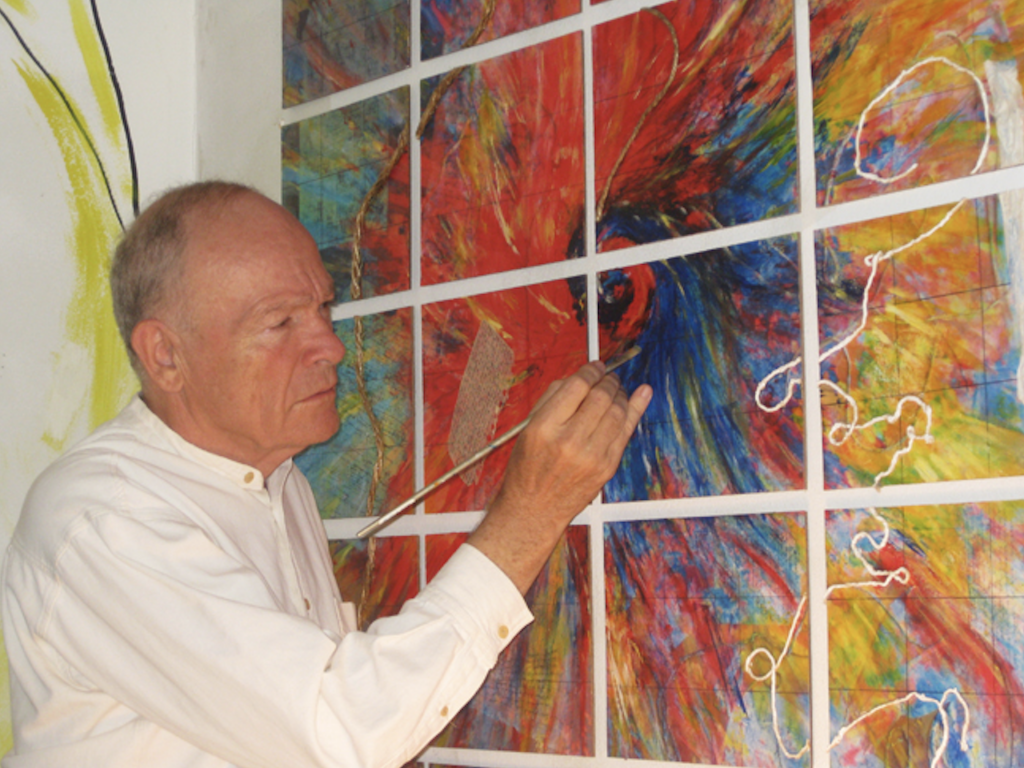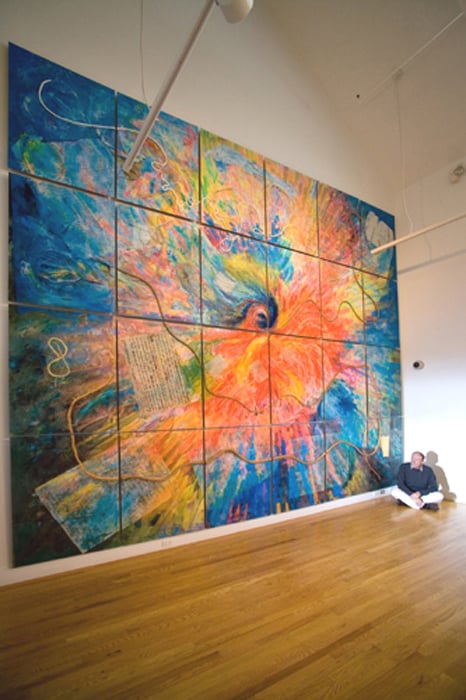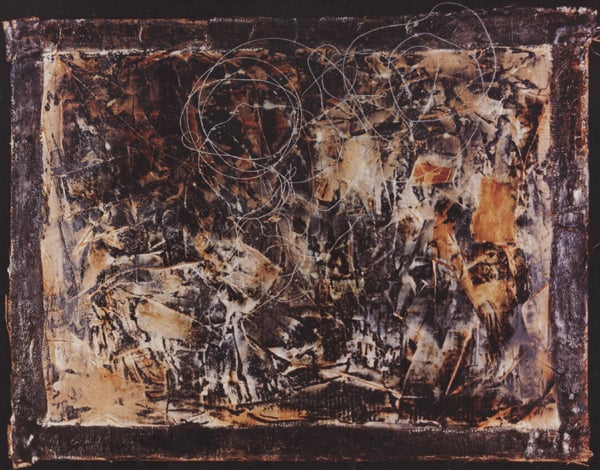Gallery Network
7 Questions for American Artist Rudy Ernst on Why He’s Embraced Technology as a Creative Tool
Ernst has recently launched a digital art platform dedicated to presenting computer-aided art.

Ernst has recently launched a digital art platform dedicated to presenting computer-aided art.

Artnet Gallery Network

Swiss-born, United States-based artist Rudy Ernst (b. 1937) has maintained a practice marked by exploration and experimentation for over half a century. His early work ranged from Surrealist-inspired pictures to interpretations of Old Master and Impressionist styles. In the 1990s, Ernst began engaging with the Internet and other computer-based technologies and the myriad artistic possibilities they offered, fusing his knowledge and skill with traditional art mediums with digital tech. He ultimately coined the term computer-aided art (CAA), demarcating a form of art-making that employs elements of both traditional and digital processes. The term was derived from the precedence and prevalence of computer-aided aspects in other industries, such as computer-aided design (CAD) in architecture and engineering.
Recently, Ernst founded CAA Gallery, a virtual art space that presents works that were originally painted (dating from between 1997 and 2002) that subsequently underwent interventions by AI computer algorithms, then printed and further enhanced by overpainting. These multimedia works by Ernst highlight the infinite potential of melding old traditions with new developments.
We spoke with Ernst to learn more about where his interest in CAA began, and what he hopes to accomplish with the recent establishment of CAA Gallery.

Rudy Ernst with his work Phoenix (2008). Courtesy of the artist.
Digital technologies first began to be integrated into your work in the 1990s. What initially inspired this transition in your practice?
In the 1990s, I embarked on a transformative journey by integrating digital technologies into my work. This shift was motivated by my lifelong fascination with high technology and the desire to create artworks that included futuristic elements beyond the capabilities of traditional painting techniques.
While many of my high school friends pursued engineering careers, I envisioned myself as a “global philosopher,” seeking a unique path that allowed me to express my artistic visions through cutting-edge means. The rapid rise of digital advancements presented a great opportunity to breathe new life into my art.
To embark on this digital exploration, I had the assistance of my son, Rudi, who guided me in becoming computer literate. With my newfound digital literacy, I could seamlessly integrate my concepts with evolving computer technologies, opening a world of new creative possibilities.
By merging art and technology, I could convey a distinct aesthetic that pushed the boundaries of my conventional artistic means. Through this synergy, my artworks took on a mesmerizing allure, captivating my mind with the fusion of the past and the future.

Rudy Ernst, Chaos and Order (1991). Courtesy of the artist.
CAA can in many ways be seen as the transformative midpoint between traditional art mediums and fully digital art—what benefits do you see in CAA versus the other ends of the spectrum?
As an abstract artist, my creative process has always been a deeply personal exploration, where my artistic vision emerged from within and materialized on my canvases. Like many other artists, I constantly sought ways to push the boundaries of my own works, yearning for continuous improvement and new avenues of expression. It was during this quest that the computer entered my life and became a close friend and collaborator.
Over the years, I embraced the power of computer-aided art (CAA) not only as a tool but as a transformative midpoint that bridges the gap between traditional art methods and entirely machine-generated art. What sets CAA apart and makes it immensely valuable to me are the following benefits: CAA allows me to leverage the full potential of digital tools and algorithms to amplify my creative works. Through digital manipulation, I can explore almost infinite variations, pushing the boundaries beyond what traditional art alone could achieve. Unlike traditional art, where revisions can be challenging, CAA also empowers me to refine my works effortlessly. With CAA, I can seamlessly integrate traditional art elements with digital techniques, resulting in a unique fusion that adds depth and complexity to my artworks. Furthermore, CAA enables me to reproduce and share my art through the creation of multimedia originals, thus reaching a wider audience worldwide.
This year, you launched CAA Gallery. What prompted you to take this step?
As an artist with a wealth of experience and a lifelong passion for exploring the creative potential of digital technologies, the idea of launching the CAA Gallery emerged as a natural progression in my journey as an artist.
Throughout my career, I have relentlessly pursued artistic innovation, constantly seeking avenues to showcase and share my work with the public. As I have grown older, this desire to present my endeavors to a wider audience has only intensified. The realization that time is a precious resource urged me to take decisive actions and create a platform where I could exhibit the product of many years of hard work and creative exploration.
That digital realm has been instrumental in transforming my art, allowing me to apply the latest 2D and 3D computer technologies to bring my visions to life. With the inception of the CAA Gallery, I found the perfect vehicle to curate and display my art in a virtual environment that I control entirely.
One of the driving forces behind the gallery’s establishment was to offer art enthusiasts and collectors worldwide the opportunity to engage with my creations. The virtual nature of the CAA Gallery transcends geographical barriers, enabling a global audience to experience my art.
Moreover, the CAA Gallery serves as a testament to the transformative power of computer-aided art, showcasing the possibilities that arise from fusing traditional artistry with cutting-edge digital techniques.

Rudy Ernst, Rembrandt – G 2118-S2 (2002). Courtesy of the artist.
Can you describe the mission or guiding principles of the platform? What do you hope to achieve through CAA Gallery?
While I consider myself a humble and private person, the establishment of the CAA Gallery is driven by a vision to create a space that celebrates the art form I hold dear—computer-aided art. The mission of the CAA Gallery is twofold: to bridge the gap between traditional analog (oil) painting methods and digitally generated art, and to showcase the unique potential of CAA as an innovative artistic medium.
Ultimately, the CAA Gallery endeavors to leave a lasting impact by elevating the recognition and appreciation of CAA as a legitimate and distinctive art form.
What advice would you give to collectors looking to expand into the CAA realm?
CAA offers a unique opportunity for collectors to acquire artworks that combine artistic excellence with cutting-edge technology for a modest initial investment that has the potential to appreciate in value over time.
As technology continues to advance, so too will the world of CAA by embracing the future and the potential for new artistic horizons.
Collecting CAA art offers a unique and exciting journey into the convergence of creativity and technology.

Rudy Ernst, Big Blue (2013). Courtesy of the artist.
What do you think the role of art in society is today?
As an artist who passionately seeks to infuse hope, beauty, and confidence into my artworks, I firmly believe that art can serve as a vehicle for expressing the human experience in all its complexities.
In today’s increasingly digital and fast-paced world, art could provide a much-needed pause—a moment for contemplation and reflection. It can evoke emotions and stimulate thoughts in an environment often dominated by superficial distractions.
While it is true that the art market has a significant commercial aspect, reducing the role of art solely to its monetary value would overlook the profound impact it has on individuals and society as a whole.
As an artist, can you tell us about what you are working on currently, or hope to work on next? Are there any ideas or any new technological advancements that you want to engage with that you haven’t yet?
My mind is always full of ideas and projects. Right now, I am entirely focused on my CAA artworks, but I am paying close attention to the advancements in the AR area (augmented reality) that I believe will soon be ready for me to jump in. AR has the potential to transform how art is experienced and appreciated, blurring the lines between the physical and digital realms. Incorporating AR could offer viewers interactive experiences by creating new dimensions of engagement. This said I am also looking into creating my own NFTs (Non-Fungible-Tokens).
Other than that, I am a happy person trying to live a long life filled with family gatherings, friendships, good meals—and champagne.
Learn more about Rudy Ernst and his work here.